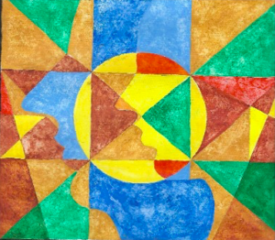Volume 11 Issues 5 May, 2021
BARBERSHOP – Hair raising revelations!

One significant outcome of the COVID lockdown had been and continues to be men’s growing beards and outgrown hair. There is no end to their lamenting…no selfies, no video calls and doling out apologies for their new outlandish looks. Why is this sob story important? The barbers who tame the mane, snipping at it much like a gardener at the hedges have a story of evolution. Strangely enough it finds links to medical sciences as my exploration revealed…
The practice of Western medicine of the 11-12th century was a ‘secular profession’ of the monk-practitioners at the monasteries. The herb garden therein had different medicinal plants which along with the regular vegetable garden would be able to supply any poultice, purge, or infusion the physician might need to serve the inmates at their infirmary. The monastery housed barbers who ensured the tonsured fringe look of the monks. The haircut essentially entailed the subservience to ‘God’.
Soon, when the monk-practitioners began to liaise with commoners and offer their services to the outside folk as a paid engagement, the Church prohibited the clergy from spilling blood. The barbers possessed not just the tools but also the skillset for elementary practices like bloodletting and leeching based on the theory of humors.
Thus, came into being Barber-Surgeons.
During the Renaissance, field barbers accompanied the monks onto battlefields; sometimes were even placed in troops and performed procedures like limb amputation. Other documented evidence to their credit includes surgeries like neck manipulation, tooth extraction, draining of cysts with wicks, lancing of boils, administering enemas and fire cupping.
Even as science evolved and surgery diversified, barbers and surgeons continued to have the same trade guild until the 1700’s. The traditional red and white barber’s pole hints at the bygone era of bloodletting and bandages. In spite of their dedicated and unique service, there was no formal educational course for them as they were never seen in the capacity of doctors.
In the modern times, barbershops are zones that allow for conversations that can be private or inclusive; lame or distinguished. It presents itself as a non-judgmental space with keen listeners and advisors at the helm. The
Confess Project, a mental health initiative in the United States, for boys and men of color has trained barbers to sharpen their skills at listening to unattended mental health problems in their clients and promoting them to seek professional help. NHS Birmingham (UK) came up with a community-based initiative of making available a magazine called ‘Barbershop’. This magazine is free in barbershops in Birmingham and focuses on destigmatising issues of mental health.
Ever wondered why do procedures like head massage or hair trimming feel so soothing at a barbershop or a salon?
Recent research has explored the concept of Autonomous Sensory Meridian Response (ASMR). It is a perceptual phenomenon in which specific stimuli (ASMR “triggers” of different sensory modalities) elicit pleasurable tingling sensations primarily to the head and neck region eventually radiating to other parts of the body and finds links to synaethesia.
Thus, a visit to the barbershop is an event that silently encompasses a rich heritage, an opportunity for male bonhomie and scope for therapy! And depriving a male of it is truly punishing!!!

